Ortiz de Montellano Paul R.(Ed.) Cytochrome P450. Structure, Mechanism, and Biochemistry
Подождите немного. Документ загружается.

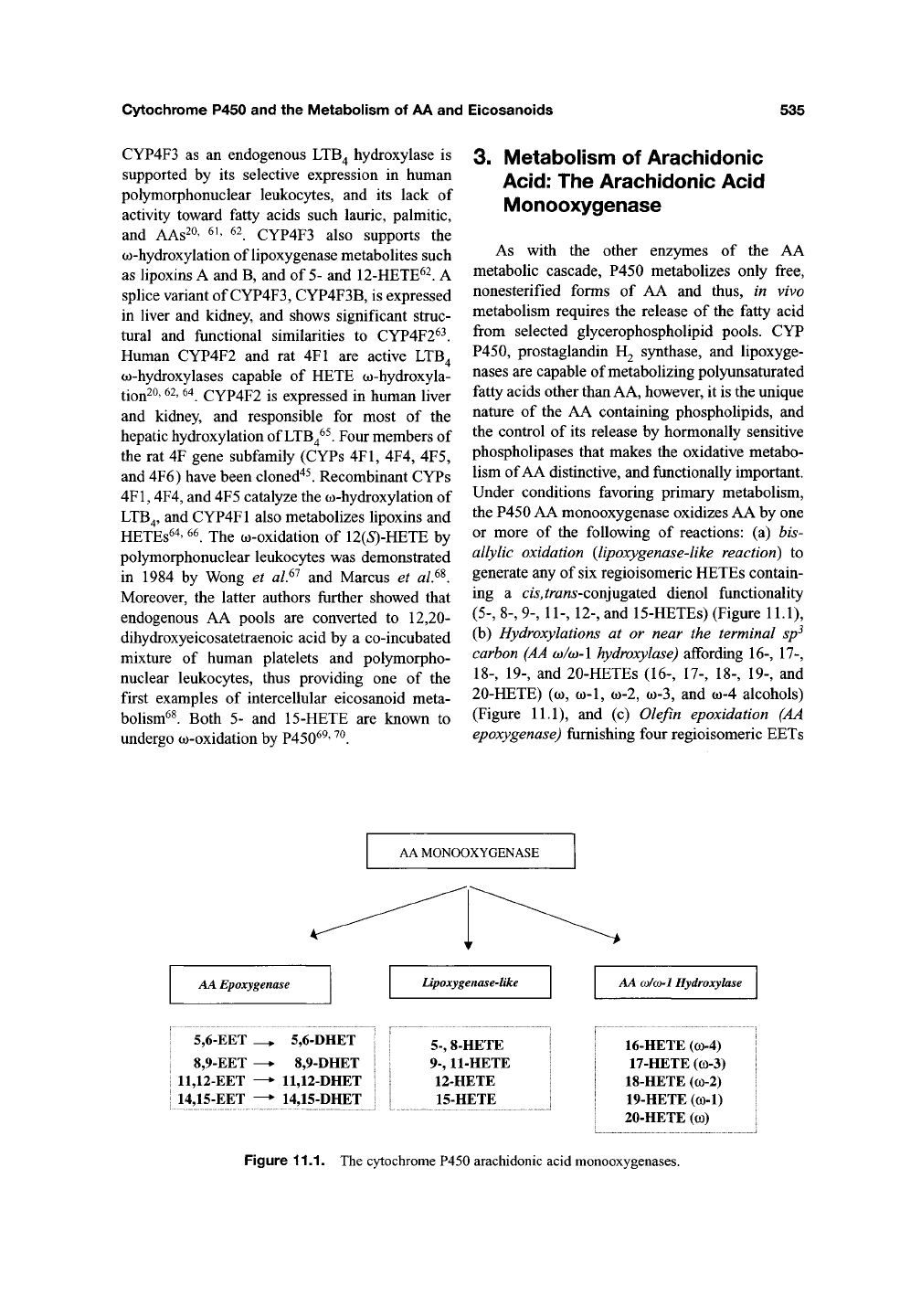
Cytochrome
P450
and the
Metabolism
of
AA and
Eicosanoids
535
CYP4F3
as an
endogenous LTB^ hydroxylase
is
supported
by its
selective expression
in
human
polymorphonuclear leukocytes,
and its
lack
of
activity toward fatty acids such lauric, palmitic,
and AAs^O'
^i, 62
CYP4F3 also supports
the
(o-hydroxylation of lipoxygenase metabolites such
as lipoxins A and B, and
of
5- and 12-HETE^2.
A
splice variant of
CYP4F3,
CYP4F3B, is expressed
in liver and kidney,
and
shows significant struc-
tural
and
fiinctional similarities
to
CYP4F2^^.
Human CYP4F2
and rat 4F1 are
active LTB^
(o-hydroxylases capable
of
HETE (o-hydroxyla-
tion^^' ^^'
^'^.
CYP4F2
is
expressed
in
human liver
and kidney,
and
responsible
for
most
of the
hepatic hydroxylation of
LTB^^^.
Four members of
the
rat
4F gene subfamily (CYPs 4F1, 4F4, 4F5,
and 4F6) have been cloned"^^. Recombinant CYPs
4F1,4F4, and 4F5 catalyze the o)-hydroxylation of
LTB4, and CYP4F1 also metabolizes lipoxins and
HETEs64'
66
xhe
co-oxidation
of
12(5)-HETE
by
polymorphonuclear leukocytes was demonstrated
in 1984
by
Wong
et al^^ and
Marcus
et al^^.
Moreover,
the
latter authors further showed that
endogenous
AA
pools
are
converted
to
12,20-
dihydroxyeicosatetraenoic acid by
a
co-incubated
mixture
of
human platelets
and
polymorpho-
nuclear leukocytes, thus providing
one of the
first examples
of
intercellular eicosanoid meta-
bolism^^ Both
5- and
15-HETE
are
known
to
undergo o)-oxidation by P450^^' ^^.
3. Metabolism of Arachidonic
Acid:
The Arachidonic Acid
IVIonooxygenase
As with
the
other enzymes
of the AA
metabolic cascade, P450 metabolizes only free,
nonesterified forms
of AA and
thus,
in
vivo
metabolism requires
the
release
of
the fatty acid
from selected glycerophospholipid pools.
CYP
P450,
prostaglandin
H2
synthase,
and
lipoxyge-
nases are capable of metabolizing polyunsaturated
fatty acids other than
AA,
however, it is the unique
nature
of
the
AA
containing phospholipids,
and
the control
of
its release
by
hormonally sensitive
phospholipases that makes the oxidative metabo-
lism of AA distinctive, and fimctionally important.
Under conditions favoring primary metabolism,
the P450 AA monooxygenase oxidizes AA by one
or more
of the
following
of
reactions:
(a) bis-
allylic oxidation (lipoxygenase-like reaction)
to
generate any of six regioisomeric HETEs contain-
ing
a
cis,trans'Con]u%2iiQ6.
dienol functionality
(5-,
8-, 9-, 11-, 12-, and 15-HETEs) (Figure 11.1),
(b) Hydroxylations
at or
near
the
terminal sp^
carbon (AA w/w-l hydroxylase) affording 16-, 17-,
18-,
19-, and 20-HETEs (16-,
17-,
18-, 19-,
and
20-HETE) (o), (0-1, (0-2, o)-3, and
(J()-4
alcohols)
(Figure 11.1),
and (c)
Olefin epoxidation
(AA
epoxygenase) frimishing four regioisomeric EETs
AA MONOOXYGENASE
AA Epoxygenase
Lipoxygenase-like
AA
(DI(J>1
Hydroxylase
5,6-EET
8,9-EET
11,12-EET
14,15-EET
^
5,6-DHET
8,9-DHET
11,12-DHET
14,15-DHET
5-,
8-HETE
9-,
11-HETE
12-HETE
15-HETE
16-HETE (co-4)
17-HETE (co-3)
18-HETE (co-2)
19-HETE (co-1)
20-HETE
(CO)
Figure 11.1. The cytochrome P450 arachidonic acid monooxygenases.
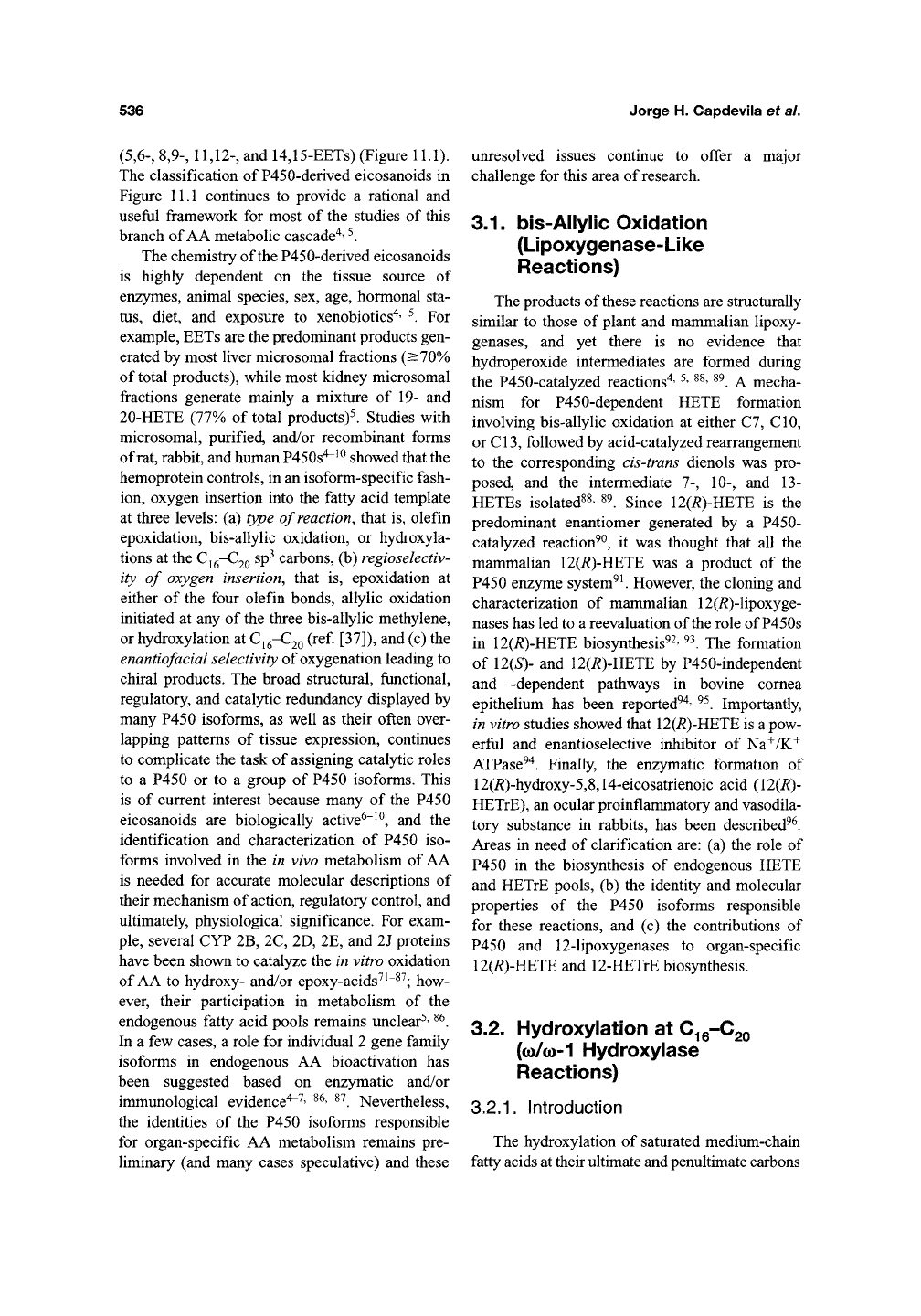
536
Jorge
H.
Capdevila
et
al.
(5,6-,
8,9-, 11,12-, and 14,15-EETs) (Figure 11.1).
The classification of P450-derived eicosanoids
in
Figure
11.1
continues
to
provide
a
rational
and
useful framework
for
most
of
the studies
of
this
branch of AA metabolic cascade"^' ^.
The chemistry of the P450-derived eicosanoids
is highly dependent
on the
tissue source
of
enzymes, animal species, sex, age, hormonal sta-
tus,
diet,
and
exposure
to
xenobiotics"^'
^. For
example, EETs are the predominant products gen-
erated by most liver microsomal fractions (>70%
of total products), while most kidney microsomal
fractions generate mainly
a
mixture
of
19-
and
20-HETE (77%
of
total products)^. Studies with
microsomal, purified, and/or recombinant forms
of rat, rabbit, and human P450s'^'^ showed that the
hemoprotein controls, in an isoform-specific fash-
ion, oxygen insertion into the fatty acid template
at three levels:
(a)
type of reaction, that is, olefin
epoxidation, bis-allylic oxidation,
or
hydroxyla-
tions at the Cjg-C2Q sp^ carbons, (b) regioselectiv-
ity
of
oxygen insertion, that
is,
epoxidation
at
either
of
the four olefin bonds, allylic oxidation
initiated
at
any
of
the three bis-allylic methylene,
or hydroxylation at
C^^-C2Q
(ref [37]), and (c) the
enantiofacial selectivity of oxygenation leading to
chiral products. The broad structural, functional,
regulatory, and catalytic redundancy displayed by
many P450 isoforms,
as
well
as
their often over-
lapping patterns
of
tissue expression, continues
to complicate the task
of
assigning catalytic roles
to
a
P450
or to a
group
of
P450 isoforms. This
is
of
current interest because many
of
the P450
eicosanoids
are
biologically active^"'^,
and the
identification
and
characterization
of
P450 iso-
forms involved
in
the
in
vivo metabolism of AA
is needed
for
accurate molecular descriptions
of
their mechanism of action, regulatory control, and
ultimately, physiological significance. For exam-
ple,
several CYP 2B, 2C, 2D, 2E, and 2J proteins
have been shown to catalyze the in vitro oxidation
of AA
to
hydroxy- and/or epoxy-acids^'"^^; how-
ever, their participation
in
metabolism
of the
endogenous fatty acid pools remains unclear^' ^^.
In
a
few cases,
a
role for individual
2
gene family
isoforms
in
endogenous
AA
bioactivation
has
been suggested based
on
enzymatic and/or
immunological evidence^^'
^^'
^^. Nevertheless,
the identities
of the
P450 isoforms responsible
for organ-specific
AA
metabolism remains pre-
liminary (and many cases speculative) and these
unresolved issues continue
to
offer
a
major
challenge for this area of research.
3.1.
bis-Allylic Oxidation
(Lipoxygenase-Like
Reactions)
The products of these reactions are structurally
similar
to
those
of
plant and mammalian lipoxy-
genases,
and yet
there
is no
evidence that
hydroperoxide intermediates
are
formed during
the P450-catalyzed reactions^' ^' ^^' ^^.
A
mecha-
nism
for
P450-dependent HETE formation
involving bis-allylic oxidation
at
either C7, CIO,
or CI3, followed by acid-catalyzed rearrangement
to
the
corresponding cis-trans dienols
was
pro-
posed,
and the
intermediate
7-, 10-, and 13-
HETEs isolated^^' ^^ sj^ce 12(i?)-HETE
is the
predominant enantiomer generated
by a
P450-
catalyzed reaction^^,
it was
thought that
all the
mammalian 12(i?)-HETE
was a
product
of the
P450 enzyme system^^ However, the cloning and
characterization
of
mammalian 12(i^)-lipoxyge-
nases has led to a reevaluation of the role of P450s
in 12(/?)-HETE biosynthesis^^'
^l
The formation
of 12(5)-
and
12(i^)-HETE
by
P450-independent
and -dependent pathways
in
bovine cornea
epithelium
has
been reported^^' ^^. Importantly,
in vitro studies showed that 12(i?)-HETE is a pow-
erful
and
enantioselective inhibitor
of
Na^/K+
ATPase^'*. Finally,
the
enzymatic formation
of
12(i^)-hydroxy-5,8,14-eicosatrienoic acid (12(i?)-
HETrE), an ocular proinflammatory and vasodila-
tory substance
in
rabbits,
has
been described^^.
Areas
in
need
of
clarification are:
(a)
the role
of
P450
in the
biosynthesis
of
endogenous HETE
and HETrE pools,
(b) the
identity and molecular
properties
of the
P450 isoforms responsible
for these reactions,
and (c) the
contributions
of
P450
and
12-lipoxygenases
to
organ-specific
12(ie)-HETE and 12-HETrE biosynthesis.
3.2. Hydroxylation
at
C^g-Cgo
((o/co-1 Hydroxylase
Reactions)
3.2.1.
Introduction
The hydroxylation
of
saturated medium-chain
fatty acids at their ultimate and penultimate carbons
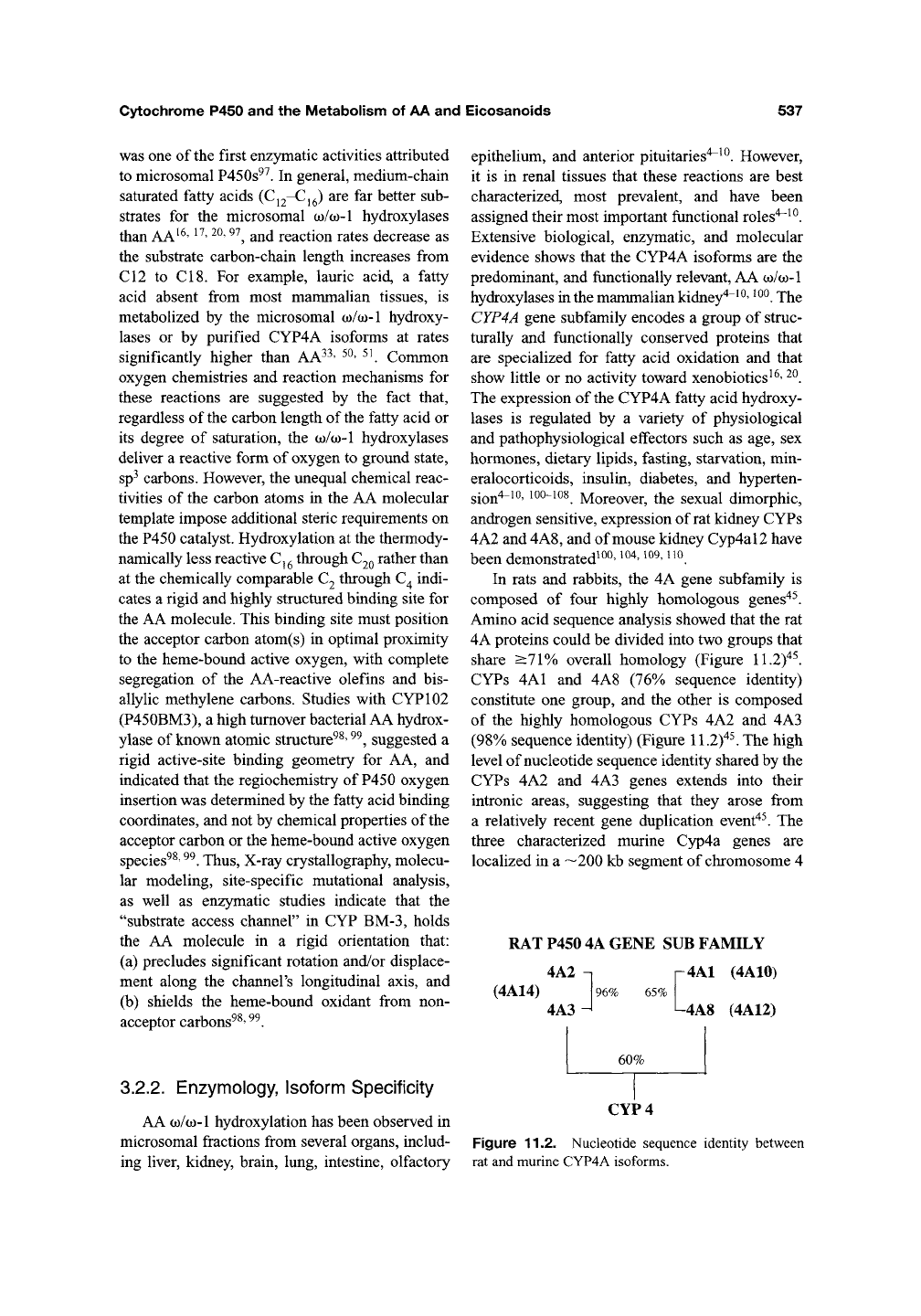
Cytochrome P450 and the Metabolism of AA and Eicosanoids
537
was one of the first enzymatic activities attributed
to microsomal P450s^^. In general, medium-chain
saturated fatty acids (Cj2-Ci5) are far better sub-
strates for the microsomal co/w-l hydroxylases
than AA^^'
^^' ^^' ^^,
and reaction rates decrease as
the substrate carbon-chain length increases from
C12 to CI8. For example, lauric acid, a fatty
acid absent from most mammalian tissues, is
metabolized by the microsomal w/w-l hydroxy-
lases or by purified CYP4A isoforms at rates
significantly higher than AA^^' ^^' ^K Common
oxygen chemistries and reaction mechanisms for
these reactions are suggested by the fact that,
regardless of
the
carbon length of
the
fatty acid or
its degree of saturation, the a)/o)-l hydroxylases
deliver a reactive form of oxygen to ground state,
sp^
carbons. However, the unequal chemical reac-
tivities of the carbon atoms in the AA molecular
template impose additional steric requirements on
the P450 catalyst. Hydroxylation at the thermody-
namically less reactive C^^ through
C2Q
rather than
at the chemically comparable C2 through C^ indi-
cates a rigid and highly structured binding site for
the AA molecule. This binding site must position
the acceptor carbon atom(s) in optimal proximity
to the heme-bound active oxygen, with complete
segregation of the AA-reactive olefins and bis-
allylic methylene carbons. Studies with CYP102
(P450BM3), a high turnover bacterial AA hydrox-
ylase of known atomic structure^^'
^^,
suggested a
rigid active-site binding geometry for AA, and
indicated that the regiochemistry of P450 oxygen
insertion was determined by the fatty acid binding
coordinates, and not by chemical properties of the
acceptor carbon or the heme-bound active oxygen
species^^'
^^.
Thus, X-ray crystallography, molecu-
lar modeling, site-specific mutational analysis,
as well as enzymatic studies indicate that the
"substrate access channel" in CYP BM-3, holds
the AA molecule in a rigid orientation that:
(a) precludes significant rotation and/or displace-
ment along the channel's longitudinal axis, and
(b) shields the heme-bound oxidant from non-
acceptor carbons^^'
^^.
3.2.2. Enzymology, Isoform Specificity
AA o)/(o-l hydroxylation has been observed in
microsomal fractions from several organs, includ-
ing liver, kidney, brain, lung, intestine, olfactory
epithelium, and anterior pituitaries^^^. However,
it is in renal tissues that these reactions are best
characterized, most prevalent, and have been
assigned their most important functional roles"^"^^.
Extensive biological, enzymatic, and molecular
evidence shows that the CYP4A isoforms are the
predominant, and functionally relevant, AA w/w-l
hydroxylases in the mammalian kidney"^"^^'
^^^.
The
CYP4A gene subfamily encodes a group of struc-
turally and functionally conserved proteins that
are specialized for fatty acid oxidation and that
show little or no activity toward xenobiotics^^' ^^.
The expression of the CYP4A fatty acid hydroxy-
lases is regulated by a variety of physiological
and pathophysiological effectors such as age, sex
hormones, dietary lipids, fasting, starvation, min-
eralocorticoids, insulin, diabetes, and hyperten-
sion"^"^^' 100-108 Moreover, the sexual dimorphic,
androgen sensitive, expression of rat kidney CYPs
4A2 and
4A8,
and of mouse kidney Cyp4al2 have
been demonstrated^o^'
^^4,
i09,110^
In rats and rabbits, the 4A gene subfamily is
composed of four highly homologous genes"^^.
Amino acid sequence analysis showed that the rat
4A proteins could be divided into two groups that
share >71% overall homology (Figure 11.2)"^^.
CYPs 4A1 and 4A8 (76% sequence identity)
constitute one group, and the other is composed
of the highly homologous CYPs 4A2 and 4A3
(98%
sequence identity) (Figure
11.2)"^^.
The high
level of nucleotide sequence identity shared by the
CYPs 4A2 and 4A3 genes extends into their
intronic areas, suggesting that they arose from
a relatively recent gene duplication event"*^. The
three characterized murine Cyp4a genes are
localized in a ---200 kb segment of chromosome 4
RAT P450 4A GENE SUB FAMILY
4A2 -, r4Al (4A10)
(4A14)
4A3^
96%
65%
60%
L4A8 (4A12)
CYP 4
Figure 11.2. Nucleotide sequence identity between
rat and murine CYP4A isoforms.
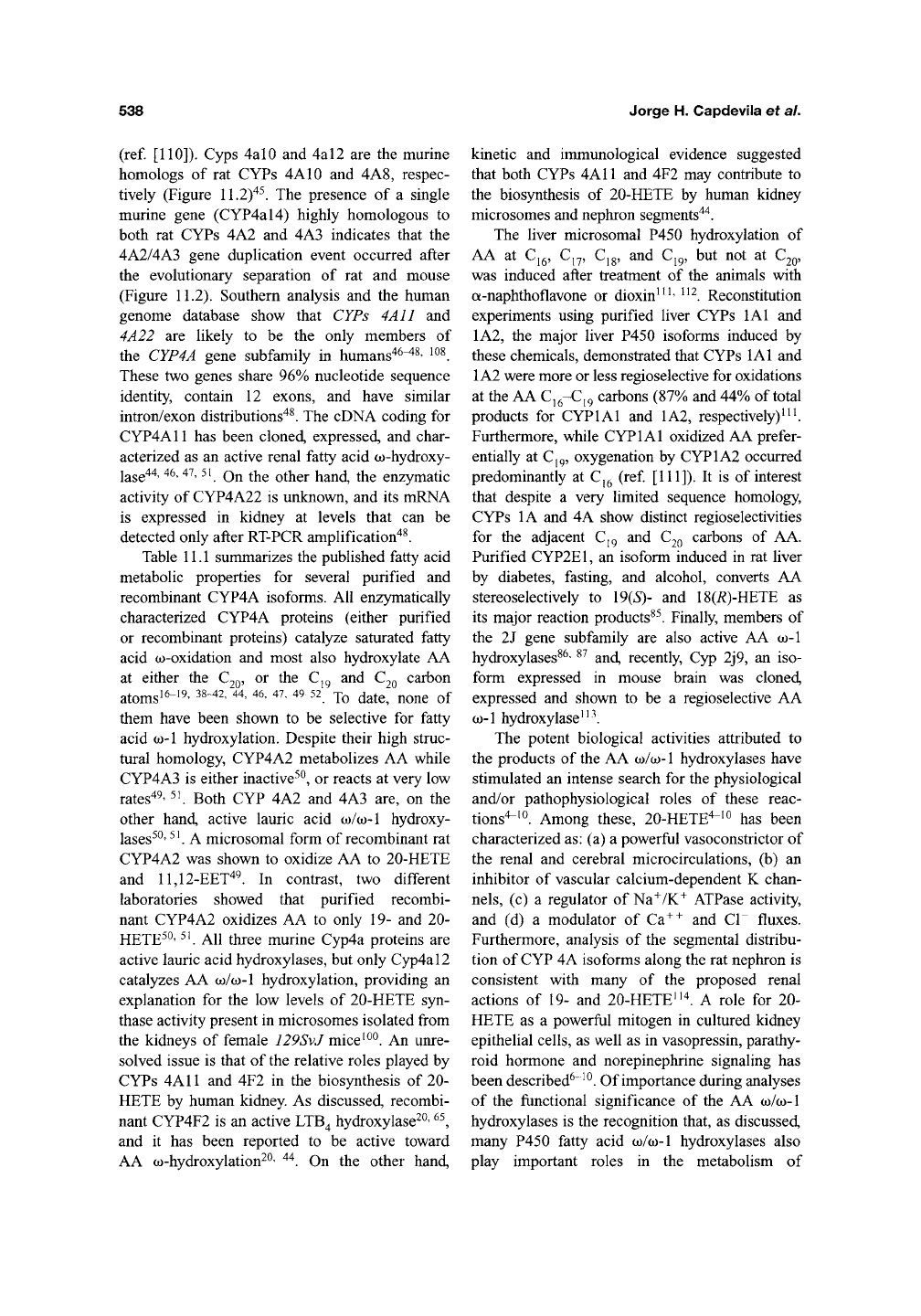
538
Jorge H. Capdevila et al.
(ref.
[110]). Cyps 4a 10
and
4a 12
are the
murine
homologs
of rat
CYPs
4A10 and 4A8,
respec-
tively (Figure 11.2)"^^.
The
presence
of a
single
murine gene (CYP4al4) highly homologous
to
both
rat
CYPs
4A2 and 4A3
indicates that
the
4A2/4A3 gene duplication event occurred after
the evolutionary separation
of rat and
mouse
(Figure 11.2). Southern analysis
and the
human
genome database show that CYPs 4All
and
4A22
are
likely
to be the
only members
of
the CYP4A gene subfamily
in
humans^^^^'
^^l
These
two
genes share
96%
nucleotide sequence
identity, contain
12
exons,
and
have similar
intron/exon distributions'^^.
The
cDNA coding
for
CYP4A11
has
been cloned, expressed,
and
char-
acterized
as an
active renal fatty acid oo-hydroxy-
lase"^"^'
^^' '*'^'
^^ On the
other hand,
the
enzymatic
activity
of
CYP4A22
is
unknown,
and its
mRNA
is expressed
in
kidney
at
levels that
can be
detected only after RT-PCR amplification"^^.
Table
11.1
summarizes
the
published fatty acid
metabolic properties
for
several purified
and
recombinant CYP4A isoforms.
All
enzymatically
characterized CYP4A proteins (either purified
or recombinant proteins) catalyze saturated fatty
acid (o-oxidation
and
most also hydroxylate
AA
at either
the C20, or the C,g and C20
carbon
atomsi6-i9, 38-12, 44, 46, 47, 49-52
^o
date, nonc
of
them have been shown
to be
selective
for
fatty
acid (0-1 hydroxylation. Despite their high struc-
tural homology, CYP4A2 metabolizes
AA
while
CYP4A3
is
either inactive^^,
or
reacts
at
very
low
rates49'
^K
Both
CYP 4A2 and 4A3 are, on the
other hand, active lauric acid w/co-l hydroxy-
lases^^'
^^
A
microsomal form
of
recombinant
rat
CYP4A2
was
shown
to
oxidize
AA to
20-HETE
and 11,12-EET'^^.
In
contrast,
two
different
laboratories showed that purified recombi-
nant CYP4A2 oxidizes
AA to
only
19- and 20-
HETE^^'
^^ All
three murine Cyp4a proteins
are
active lauric acid hydroxylases,
but
only Cyp4al2
catalyzes
AA
co/co-l hydroxylation, providing
an
explanation
for the low
levels
of
20-HETE syn-
thase activity present
in
microsomes isolated from
the kidneys
of
female 129SvJ mice'^^.
An
unre-
solved issue
is
that
of
the relative roles played
by
CYPs
4A11 and 4F2 in the
biosynthesis
of 20-
HETE
by
human kidney
As
discussed, recombi-
nant CYP4F2
is an
active LTB^ hydroxylase^^'
^\
and
it has
been reported
to be
active toward
AA co-hydroxylation^^'
^^. On the
other hand.
kinetic
and
immunological evidence suggested
that both CYPs 4A11
and 4F2 may
contribute
to
the biosynthesis
of
20-HETE
by
human kidney
microsomes and nephron segments"*"^.
The liver microsomal P450 hydroxylation
of
AA
at C^g, Cj-7, Cjg, and C^^, but not at C20,
was induced after treatment
of the
animals with
a-naphthoflavone
or
dioxin^^^' ^^^. Reconstitution
experiments using purified liver CYPs
lAl and
1A2,
the
major liver P450 isoforms induced
by
these chemicals, demonstrated that CYPs
lAl and
1A2 were more
or
less regioselective
for
oxidations
at the AA Cj^-C,9 carbons (87%
and
44%
of
total
products
for
CYPlAl
and 1A2,
respectively)^^^
Furthermore, while CYPlAl oxidized AA prefer-
entially
at C,g,
oxygenation
by
CYP1A2 occurred
predominantly
at C,^ (ref
[111]).
It is of
interest
that despite
a
very limited sequence homology,
CYPs
lA and 4A
show distinct regioselectivities
for
the
adjacent
Cjg and C2Q
carbons
of AA.
Purified CYP2E1,
an
isoform induced
in rat
liver
by diabetes, fasting,
and
alcohol, converts
AA
stereoselectively
to
19(5)-
and
18(i?)-HETE
as
its major reaction products^^. Finally, members
of
the
2J
gene subfamily
are
also active
AA w-l
hydroxylases^^' ^^
and,
recently,
Cyp 2j9, an
iso-
form expressed
in
mouse brain
was
cloned,
expressed
and
shown
to be a
regioselective
AA
o)-l hydroxylase "\
The potent biological activities attributed
to
the products
of
the
AA
(JO/CO-
1
hydroxylases have
stimulated
an
intense search
for the
physiological
and/or pathophysiological roles
of
these reac-
tions'^-'^.
Among these,
20-HETE4-IO
has
been
characterized as:
(a) a
powerful vasoconstrictor
of
the renal
and
cerebral microcirculations,
(b) an
inhibitor
of
vascular calcium-dependent
K
chan-
nels,
(c) a
regulator
of
Na^/K^ ATPase activity,
and
(d) a
modulator
of Ca^^ and CI"
fluxes.
Furthermore, analysis
of the
segmental distribu-
tion
of
CYP
4A
isoforms along
the rat
nephron
is
consistent with many
of the
proposed renal
actions
of 19- and
20-HETE"l
A
role
for 20-
HETE
as a
powerful mitogen
in
cultured kidney
epithelial cells,
as
well
as in
vasopressin, parathy-
roid hormone
and
norepinephrine signaling
has
been described^"^^. Of importance during analyses
of
the
functional significance
of the AA
(o/w-l
hydroxylases
is the
recognition that,
as
discussed,
many P450 fatty acid
w/w-l
hydroxylases also
play important roles
in the
metabolism
of
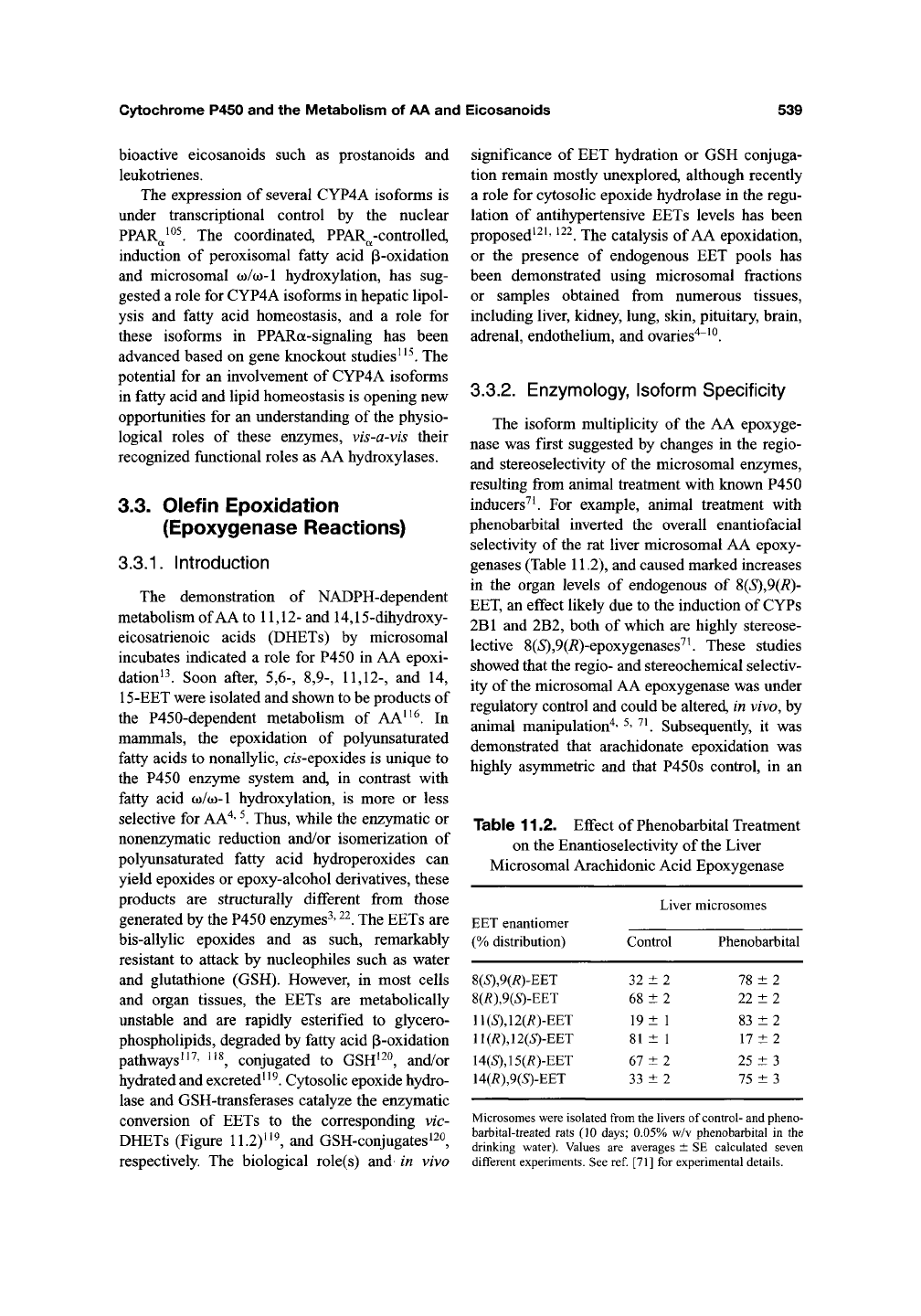
Cytochrome P450 and the Metabolism of AA and Eicosanoids
539
bioactive eicosanoids such as prostanoids and
leukotrienes.
The expression of several CYP4A isoforms is
under transcriptional control by the nuclear
PPAR^^^^ The coordinated, PPAR^-controlled,
induction of peroxisomal fatty acid p-oxidation
and microsomal co/w-l hydroxylation, has sug-
gested a role for CYP4A isoforms in hepatic lipol-
ysis and fatty acid homeostasis, and a role for
these isoforms in PPARa-signaling has been
advanced based on gene knockout studies^^^. The
potential for an involvement of CYP4A isoforms
in fatty acid and lipid homeostasis is opening new
opportunities for an understanding of the physio-
logical roles of these enzymes, vis-a-vis their
recognized functional roles as AA hydroxylases.
3.3. Olefin Epoxidation
(Epoxygenase Reactions)
3.3.1.
Introduction
The demonstration of NADPH-dependent
metabolism of AA to 11,12- and 14,15-dihydroxy-
eicosatrienoic acids (DHETs) by microsomal
incubates indicated a role for P450 in AA epoxi-
dation^l Soon after, 5,6-, 8,9-, 11,12-, and 14,
15-EET were isolated and shown to be products of
the P450-dependent metabolism of AA^^^. In
mammals, the epoxidation of polyunsaturated
fatty acids to nonallylic,
cis-epoxidQs
is unique to
the P450 enzyme system and, in contrast with
fatty acid co/w-l hydroxylation, is more or less
selective for AA^'
^.
Thus, while the enzymatic or
nonenzymatic reduction and/or isomerization of
polyunsaturated fatty acid hydroperoxides can
yield epoxides or epoxy-alcohol derivatives, these
products are structurally different from those
generated by the P450 enzymes^'
^^.
The EETs are
bis-allylic epoxides and as such, remarkably
resistant to attack by nucleophiles such as water
and glutathione (GSH). However, in most cells
and organ tissues, the EETs are metabolically
unstable and are rapidly esterified to glycero-
phospholipids, degraded by fatty acid p-oxidation
pathways^^^' ^^^, conjugated to GSH^^^, and/or
hydrated and excreted^
^^.
Cytosolic epoxide hydro-
lase and GSH-transferases catalyze the enzymatic
conversion of EETs to the corresponding vic-
DHETs (Figure 11.ly^^, and GSH-conjugatesi^o,
respectively. The biological role(s) and in vivo
significance of EET hydration or GSH conjuga-
tion remain mostly unexplored, although recently
a role for cytosolic epoxide hydrolase in the regu-
lation of antihypertensive EETs levels has been
proposed^^^' ^^^. The catalysis of AA epoxidation,
or the presence of endogenous EET pools has
been demonstrated using microsomal fractions
or samples obtained from numerous tissues,
including liver, kidney, lung, skin, pituitary, brain,
adrenal, endothelium, and ovaries"^"^^.
3.3.2. Enzymology, Isoform Specificity
The isoform multiplicity of the AA epoxyge-
nase was first suggested by changes in the regio-
and stereoselectivity of the microsomal enzymes,
resulting from animal treatment with known P450
inducers^ ^ For example, animal treatment with
phenobarbital inverted the overall enantiofacial
selectivity of the rat liver microsomal AA epoxy-
genases (Table 11.2), and caused marked increases
in the organ levels of endogenous of S(S),9(R)-
EET, an effect likely due to the induction of CYPs
2B1 and 2B2, both of which are highly stereose-
lective 8(*S),9(i?)-epoxygenases^^ These studies
showed that the regio- and stereochemical selectiv-
ity of
the
microsomal AA epoxygenase was under
regulatory control and could be altered, in vivo, by
animal manipulation"^' ^' ^^ Subsequently, it was
demonstrated that arachidonate epoxidation was
highly asymmetric and that P450s control, in an
Table 11.2. Effect of Phenobarbital Treatment
on the Enantioselectivity of
the
Liver
Microsomal Arachidonic Acid Epoxygenase
EET enantiomer
(% distribution)
8(5),9(i?)-EET
8(i?),9(5)-EET
U{S),l2{RyEET
ll(RX12(S)-EET
l4(S),l5{RyEET
14(R19(S)-EET
Liver
Control
32 ±2
68 ±2
19 ± 1
81 ± 1
67 ±2
33 ±2
microsomes
Phenobarbital
78 ±2
22 ±2
83 ±2
17 ±2
25 ±3
75 ±3
Microsomes were isolated from the livers of
control-
and pheno-
barbital-treated rats (10 days; 0.05% w/v phenobarbital in the
drinking water). Values are averages ± SE calculated seven
different experiments. See ref [71] for experimental details.

540
Jorge H. Capdevila et al.
isoform-specific fashion, the regio- and enantiose-
lectivities of the reaction^'
^' ^^' ^^"^'^' ^^.
These prop-
erties of the AA epoxygenase are in contrast with
those of prostaglandin H2 synthases, where the
known isoforms of the enzyme oxidize AA to the
same single product^' ^.
Another distinctive feature of the AA epoxyge-
nase pathway is the ability of a single P450 isoform
to epoxidize, stereoselectively, multiple olefins of
the AA template. For example, purified recombi-
nant rat kidney CYP2C23 generates 11,12-EET as
its major reaction product (58% of total) but, it is
also an efficient AA 8,9-, and 14,15-epoxygenase^^.
Despite this limited regioselectivity, CYP2C23 is
highly stereoselective and forms the corresponding
8(i?),9(*S)-, n(R),l2(S)-, and 14(5), 15(i?)-EETs
enantiomers with optical purities of
94%,
89%, and
75%,
respectively^'^. On the other hand, the other
two 2C AA epoxygenases expressed in rat kidney,
CYPs 2C11 and 2C24, show moderate regioselec-
tivity for the 11,12- and 14,15-olefins'^^, and epox-
idized the 8,9- and 14,15-olefins with opposing
enantiofacial selectivities^^^. Extensive studies with
a variety of organ purified and/or recombmant
epoxygenases, including several CYP 2B and 2C
isoforms, showed that: (a) with the exception of rat
CYP2B12, which generates 11,12-EET as nearly
the only reaction
product'^'^,
most do not catalyze the
selective epoxidation of a single AA olefin to the
exclusion of the other
three"^'
^,
and (b) most mam-
malian P450 isoforms preferentially epoxidize the
11,12-
and 14,15-double
bonds'^'
^.
The role that sin-
gle amino acid residues play in the regio- and stere-
ochemical selectivity of AA epoxidation was
revealed by replacements introduced into rat and
bacterial P450s 2B1 and BM3, respectively^^' ^^.
Recombinant CYP2B1 metabolizes AA to predom-
inantly 11,12- and 14,15-EET^^. Replacement of
isoleucine 114 for alanine in CYP2B1, changed its
regioselectivity toward the preferential epoxidation
of the AA 5,6- and 8,9-olefins^^. On the other hand,
a single active-site replacement, phenylalanine 78
for valine, changed P450 BM3 from a predomi-
nantly AA 18(7^)-hydroxylase into a regio- and
enantioselective
14(R),
15(iS)-epoxygenase (14(R\
15(5)-EET, >98% of total products)^^. These
studies indicate that the outcome of the reactions
catalyzed by many of these highly homologous
P450 isoforms is determined by a few amino acid
residues, strategically located within the confine-
ments of what, in most other cases, is known to
be a rather promiscuous active-site cavity.
Reconstitution experiments using purified
P450 isoforms and/or recombinant proteins show
that most AA epoxygenases belong to the CYP 2
gene family^^^. The CYP2B and 2C subfamily
isoforms identified so far as epoxygenases
include rat 2B1, 2B2, 2B12, 2C11,
2C23,
and
2C24;
rabbit 2B4, 2C1, and 2C2; mouse 2b
19,
2c37,
2c38, 2c39, and 2c40; and human 2C8,
2C9/2C10, 2C18, and 2C19 (refs [4H10],
[71]-[83],
[123]). On the other hand, CYPs 2J2
and 2J4 have also been identified as organ-
specific epoxygenases and o)-l hydroxylases^^' ^^.
CYPs lAl, 1A2, and 2E1 are active AA Wco-l
oxygenases, that also produce low and variable
amounts of EETs (<20% of total products)^^'
80,85 ^ P45Q purified from the livers of dioxin-
treated chick embryos has structural features typ-
ical of proteins of the lA gene subfamily, but
metabolizes AA to EETs as the major reaction
products^^'*. Recent studies characterized 11,12-
EET as an "endothelium-derived hyperpolarizing
factor" (EDHF)'25 and CYP2C34, the porcine
homolog of human CYPs 2C8 and 2C9, as a
coronary artery EDHF synthase'^^. While mem-
bers of the CYP2C gene subfamily share exten-
sive sequence homology, this structural homology
is often accompanied by significant catalytic het-
erogeneity^' ^ For example, CYPs 2C8 and 2C9
proteins are —90% homologous in their amino
acid sequences, yet recombinant CYPs 2C8 and
2C9 epoxidize AA with distinct regio- and stereo-
chemical selectivities^'.
Comparisons of the regio- and enantioselectiv-
ity of the microsomal epoxygenases with that
of purified recombinant P450 isoforms, as well
as antibody inhibition experiments indicate that
CYPs 2C11 and 2C9, and 2C23 and 2C8 are the
major AA epoxygenases in rat and human liver
and kidney, respectively^' ^^' ^'' '^^. Thus, for
example, of the three major 2C epoxygenases
expressed in the rat kidney, CYPs 2C11,
2C23,
and 2C24 (ref [123]), only CYP2C23 mimics the
regio-
and stereochemical selectivity of the micro-
somal enzymes^^' '^^. CYP2C23 was shown to be
abundantly expressed in rat kidney, and anti-P450
2C23 antibodies were selective inhibitors of the
renal microsomal epoxygenase^' ^^^. Furthermore,
with the exception of CYPs 2C23 and 2C11,
none of the members of the CYP2 gene family
expressed in kidney, including 2A, 2B, 2C, 2E,
and 2J isoforms, can account for the degree of
regio-
and stereoselectivity displayed by the rat
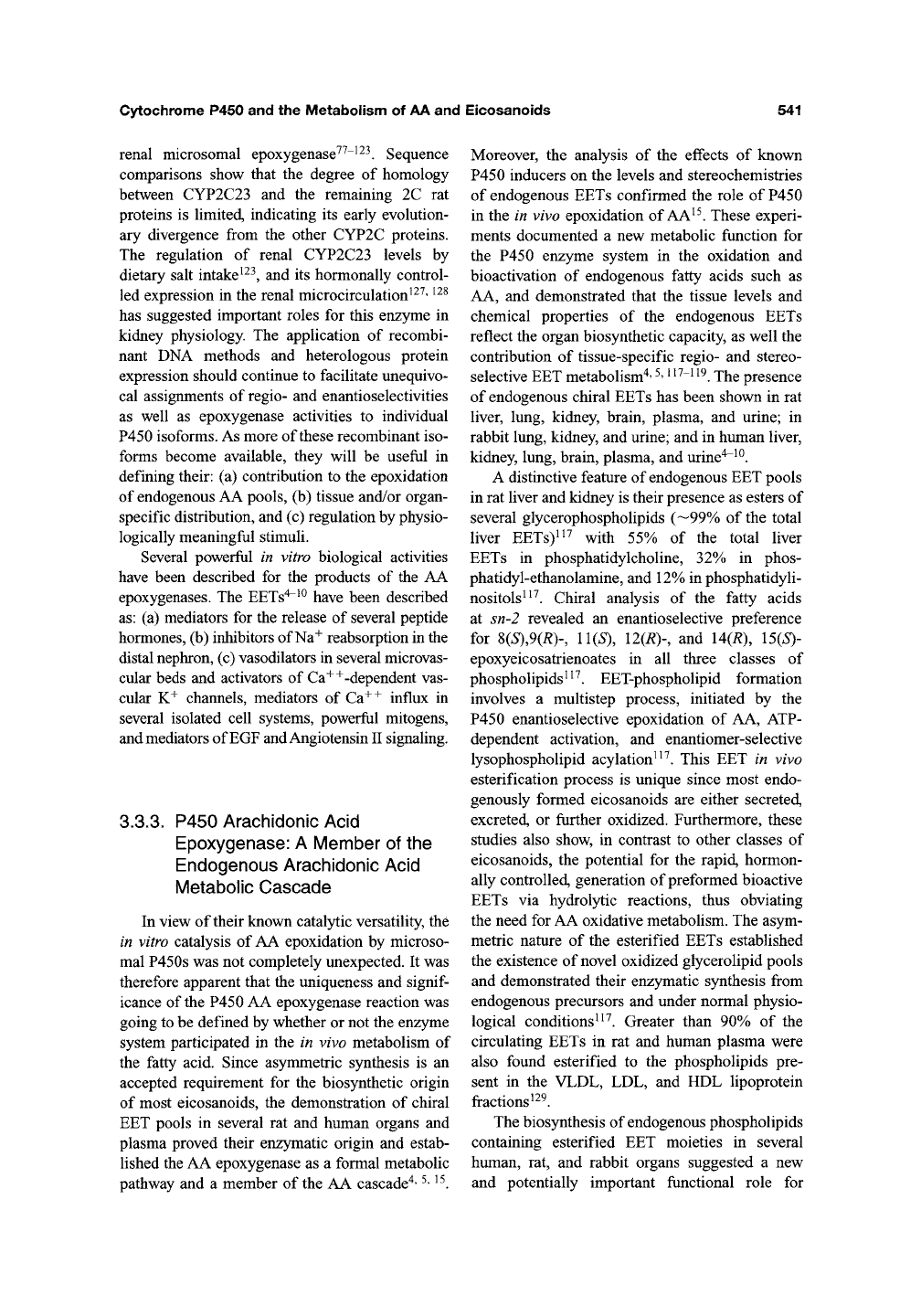
Cytochrome P450 and the Metabolism of AA and Eicosanoids
541
renal microsomal epoxygenase^^"^^^. Sequence
comparisons show that the degree of homology
between CYP2C23 and the remaining 2C rat
proteins is limited, indicating its early evolution-
ary divergence from the other CYP2C proteins.
The regulation of renal CYP2C23 levels by
dietary salt intake ^^^, and its hormonally control-
led expression in the renal microcirculation^^^' ^^^
has suggested important roles for this enzyme in
kidney physiology The application of recombi-
nant DNA methods and heterologous protein
expression should continue to facilitate unequivo-
cal assignments of regio- and enantioselectivities
as well as epoxygenase activities to individual
P450 isoforms. As more of these recombinant iso-
forms become available, they will be useful in
defining their: (a) contribution to the epoxidation
of endogenous AA pools, (b) tissue and/or organ-
specific distribution, and (c) regulation by physio-
logically meaningful stimuli.
Several powerful in vitro biological activities
have been described for the products of the AA
epoxygenases. The EETs"^^^ have been described
as:
(a) mediators for the release of several peptide
hormones, (b) inhibitors of Na^ reabsorption in the
distal nephron, (c) vasodilators in several microvas-
cular beds and activators of Ca++-dependent vas-
cular K^ channels, mediators of Ca^^ influx in
several isolated cell systems, powerful mitogens,
and mediators of EGF and Angiotensin II signaling.
3.3.3. P450 Arachidonic Acid
Epoxygenase: A Member of the
Endogenous Arachidonic Acid
IVIetabolic Cascade
In view of their known catalytic versatility, the
in vitro catalysis of AA epoxidation by microso-
mal P450s was not completely unexpected. It was
therefore apparent that the uniqueness and
signif-
icance of the P450 AA epoxygenase reaction was
going to be defined by whether or not the enzyme
system participated in the in vivo metabolism of
the fatty acid. Since asymmetric synthesis is an
accepted requirement for the biosynthetic origin
of most eicosanoids, the demonstration of chiral
EET pools in several rat and human organs and
plasma proved their enzymatic origin and estab-
lished the AA epoxygenase as a formal metabolic
pathway and a member of the AA cascade^' ^' ^^.
Moreover, the analysis of the effects of known
P450 inducers on the levels and stereochemistries
of endogenous EETs confirmed the role of P450
in the in vivo epoxidation of
AA^^.
These experi-
ments documented a new metabolic function for
the P450 enzyme system in the oxidation and
bioactivation of endogenous fatty acids such as
AA, and demonstrated that the tissue levels and
chemical properties of the endogenous EETs
reflect the organ biosynthetic capacity, as well the
contribution of tissue-specific regio- and stereo-
selective EET metabolism"^'
^'
n^-iiQ jj^g presence
of endogenous chiral EETs has been shown in rat
liver, lung, kidney, brain, plasma, and urine; in
rabbit lung, kidney, and urine; and in human liver,
kidney, lung, brain, plasma, and urine"^^^.
A distinctive feature of endogenous EET pools
in rat liver and kidney is their presence as esters of
several glycerophospholipids (—99% of the total
liver EETs)^^^ with 55% of the total liver
EETs in phosphatidylcholine, 32% in phos-
phatidyl-ethanolamine, and 12% in phosphatidyli-
nositols^^^. Chiral analysis of the fatty acids
at sn-2 revealed an enantioselective preference
for S(S),9(Ry, 11(5), 12(i?)-, and 14{R), 15(5)-
epoxyeicosatrienoates in all three classes of
phospholipids^ ^^. EET-phospholipid formation
involves a multistep process, initiated by the
P450 enantioselective epoxidation of AA, ATP-
dependent activation, and enantiomer-selective
lysophospholipid acylation^^^. This EET in vivo
esterification process is unique since most endo-
genously formed eicosanoids are either secreted,
excreted, or further oxidized. Furthermore, these
studies also show, in contrast to other classes of
eicosanoids, the potential for the rapid, hormon-
ally controlled, generation of preformed bioactive
EETs via hydrolytic reactions, thus obviating
the need for AA oxidative metabolism. The asym-
metric nature of the esterified EETs established
the existence of novel oxidized glycerolipid pools
and demonstrated their enzymatic synthesis from
endogenous precursors and under normal physio-
logical conditions^ ^^. Greater than 90% of the
circulating EETs in rat and human plasma were
also found esterified to the phospholipids pre-
sent in the VLDL, LDL, and HDL lipoprotein
fractions ^^^.
The biosynthesis of endogenous phospholipids
containing esterified EET moieties in several
human, rat, and rabbit organs suggested a new
and potentially important functional role for
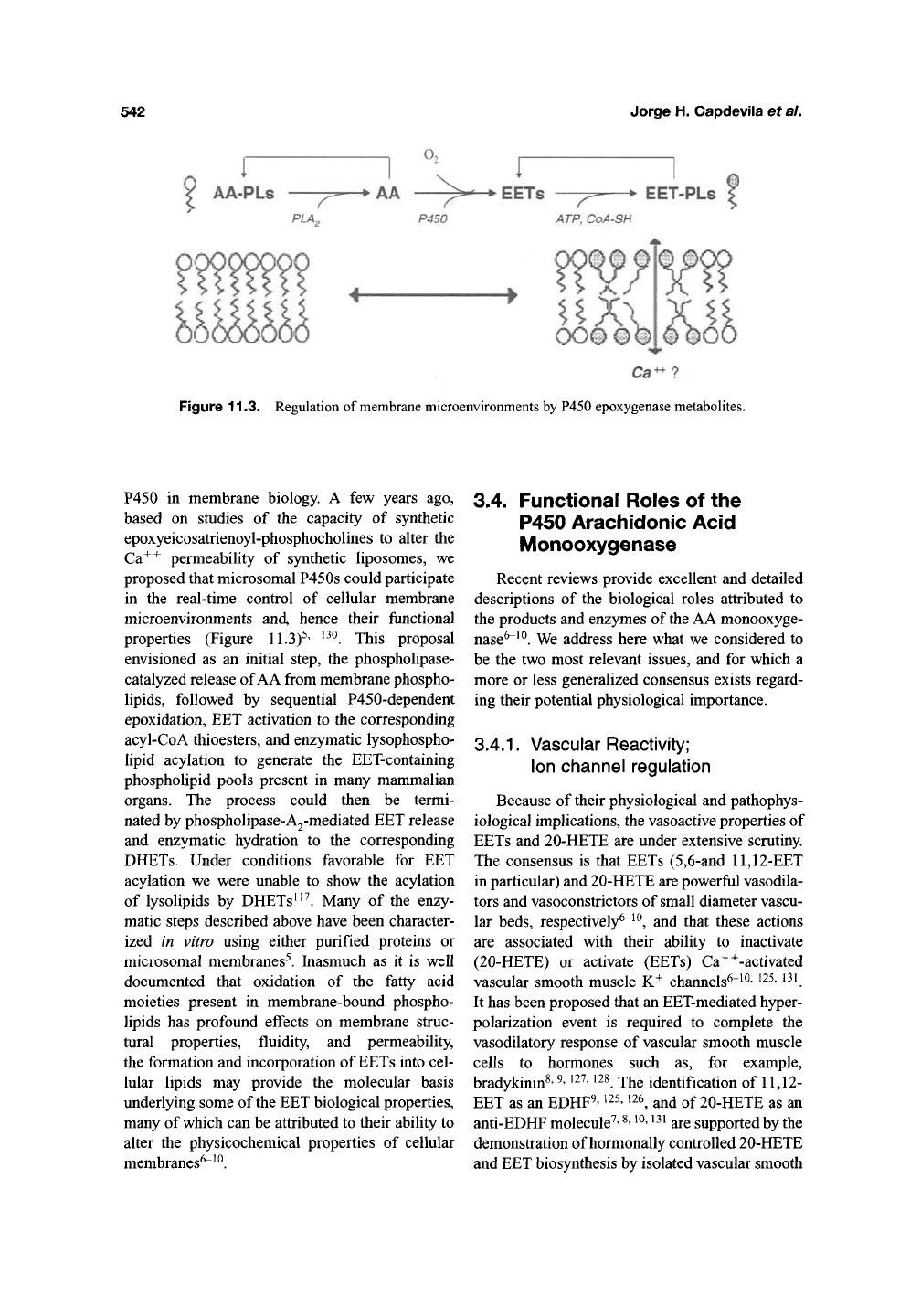
542
Jorge H. Capdevila et al.
?
i
AA-PLs
o.
-•AA
PLA.
P>-' > EETs —p-
P450 ATP, CoA-SH
*• EET-PLs
mm^
,
00©© a
U
Ca^7
Figure 11.3. Regulation of membrane microenvironments by P450 epoxygenase metabolites.
P450 in membrane biology. A few years ago,
based on studies of the capacity of synthetic
epoxyeicosatrienoyl-phosphochohnes to alter the
Ca^^ permeability of synthetic liposomes, we
proposed that microsomal P450s could participate
in the real-time control of cellular membrane
microenvironments and, hence their functional
properties (Figure 11.3)^' ^^^. This proposal
envisioned as an initial step, the phospholipase-
catalyzed release of AA from membrane phospho-
lipids,
followed by sequential P450-dependent
epoxidation, EET activation to the corresponding
acyl-CoA thioesters, and enzymatic lysophospho-
lipid acylation to generate the EET-containing
phospholipid pools present in many mammalian
organs. The process could then be termi-
nated by phospholipase-A2-mediated EET release
and enzymatic hydration to the corresponding
DHETs. Under conditions favorable for EET
acylation we were unable to show the acylation
of lysolipids by DHETs ^'^. Many of the enzy-
matic steps described above have been character-
ized in vitro using either purified proteins or
microsomal membranes^. Inasmuch as it is well
documented that oxidation of the fatty acid
moieties present in membrane-bound phospho-
lipids has profound effects on membrane struc-
tural properties, fluidity, and permeability,
the formation and incorporation of EETs into cel-
lular lipids may provide the molecular basis
underlying some of the EET biological properties,
many of which can be attributed to their ability to
alter the physicochemical properties of cellular
membranes^"^^.
3.4. Functional Roles of the
P450 Arachidonic Acid
Monooxygenase
Recent reviews provide excellent and detailed
descriptions of the biological roles attributed to
the products and enzymes of
the
AA monooxyge-
nase^
^^. We address here what we considered to
be the two most relevant issues, and for which a
more or less generalized consensus exists regard-
ing their potential physiological importance.
3.4.1.
Vascular Reactivity;
Ion channel regulation
Because of their physiological and pathophys-
iological implications, the vasoactive properties of
EETs and 20-HETE are under extensive scrutiny.
The consensus is that EETs (5,6-and 11,12-EET
in particular) and 20-HETE are powerful vasodila-
tors and vasoconstrictors of small diameter vascu-
lar beds, respectively^^^, and that these actions
are associated with their ability to inactivate
(20-HETE) or activate (EETs) Ca++-activated
vascular smooth muscle K^ channels^"^^' ^^^' ^^^
It has been proposed that an EET-mediated hyper-
polarization event is required to complete the
vasodilatory response of vascular smooth muscle
cells to hormones such as, for example,
bradykinin^'
^'
^^7,
i28 jj^^ identification of 11,12-
EET as an EDHF^' 1^5, i26^ ^nd of 20-HETE as an
anti-EDHF molecule^'
^' ^^' ^^^
are supported by the
demonstration of hormonally controlled 20-HETE
and EET biosynthesis by isolated vascular smooth
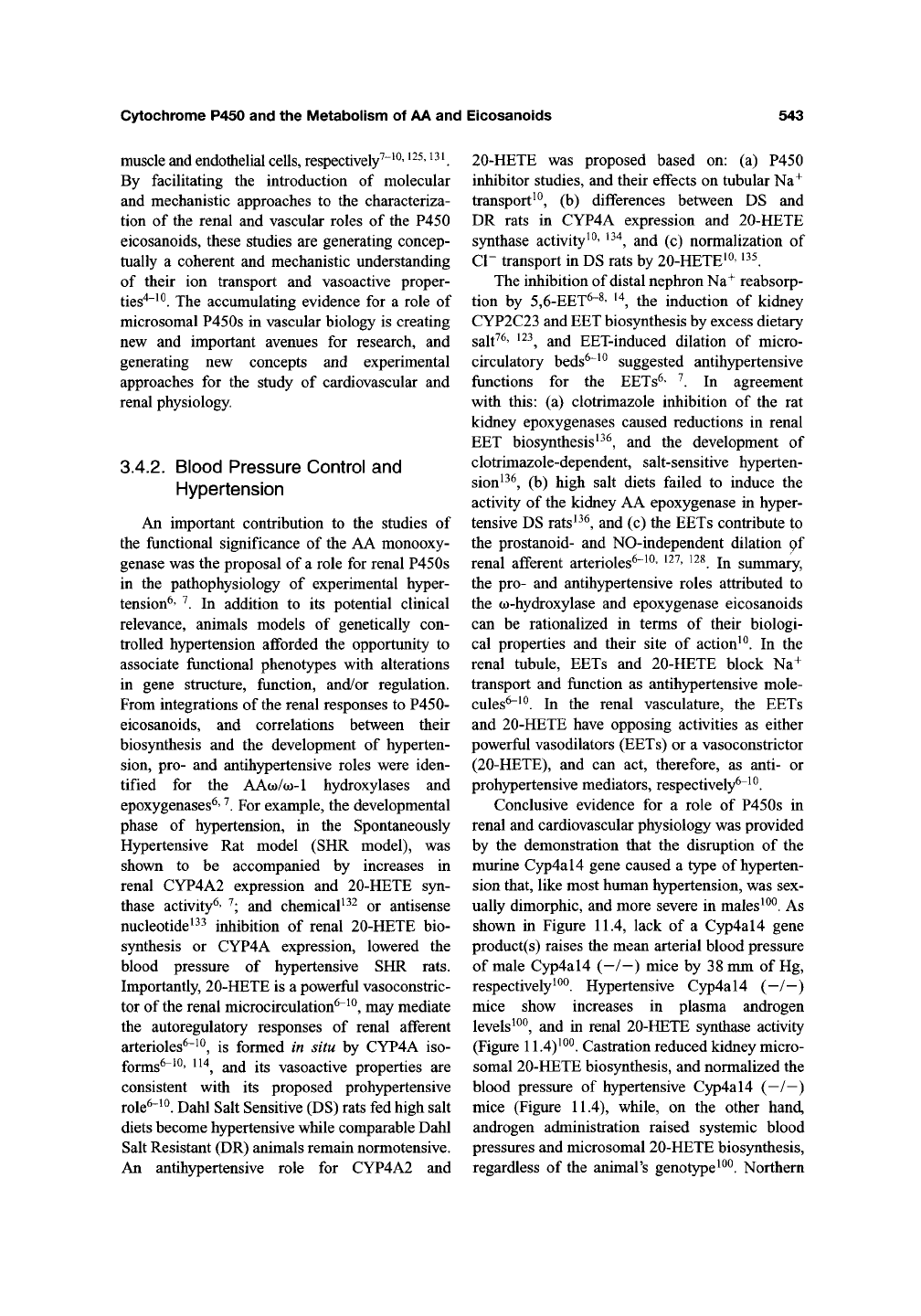
Cytochrome P450 and the Metabolism of AA and Eicosanoids 543
muscle and endothelial cells, respectively^"^^'
^25,
i3i
By facilitating the introduction of molecular
and mechanistic approaches to the characteriza-
tion of the renal and vascular roles of the P450
eicosanoids, these studies are generating concep-
tually a coherent and mechanistic understanding
of their ion transport and vasoactive proper-
ties'^"^
^. The accumulating evidence for a role of
microsomal P450s in vascular biology is creating
new and important avenues for research, and
generating new concepts and experimental
approaches for the study of cardiovascular and
renal physiology.
3.4.2. Blood Pressure Control and
Hypertension
An important contribution to the studies of
the functional significance of the AA monooxy-
genase was the proposal of a role for renal P450s
in the pathophysiology of experimental hyper-
tension^' ^. In addition to its potential clinical
relevance, animals models of genetically con-
trolled hypertension afforded the opportunity to
associate functional phenotypes with alterations
in gene structure, function, and/or regulation.
From integrations of the renal responses to P450-
eicosanoids, and correlations between their
biosynthesis and the development of hyperten-
sion, pro- and antihypertensive roles were iden-
tified for the AAo)/o)-l hydroxylases and
epoxygenases^'
^.
For example, the developmental
phase of hypertension, in the Spontaneously
Hypertensive Rat model (SHR model), was
shown to be accompanied by increases in
renal CYP4A2 expression and 20-HETE syn-
thase activity^' ^; and chemical ^^ or antisense
nucleotide ^^^ inhibition of renal 20-HETE bio-
synthesis or CYP4A expression, lowered the
blood pressure of hypertensive SHR rats.
Importantly, 20-HETE is a powerful vasoconstric-
tor of the renal microcirculation^"^^, may mediate
the autoregulatory responses of renal afferent
arterioles'^^, is formed in situ by CYP4A iso-
forms'^^'
^^'^, and its vasoactive properties are
consistent with its proposed prohypertensive
role'i^. Dahl Salt Sensitive (DS) rats fed high salt
diets become hypertensive while comparable Dahl
Salt Resistant (DR) animals remain normotensive.
An antihypertensive role for CYP4A2 and
20-HETE was proposed based on: (a) P450
inhibitor studies, and their effects on tubular Na^
transport^^, (b) differences between DS and
DR rats in CYP4A expression and 20-HETE
synthase activity^^'
^^^,
and (c) normalization of
Cr transport in DS rats by 20-HETE^O' ^^\
The inhibition of distal nephron Na^ reabsorp-
tion by 5,6-EET'^' ^^, the induction of kidney
CYP2C23 and EET biosynthesis by excess dietary
salt^^' ^^^, and EET-induced dilation of micro-
circulatory beds'^^ suggested antihypertensive
functions for the EETs^' ^. In agreement
with this: (a) clotrimazole inhibition of the rat
kidney epoxygenases caused reductions in renal
EET biosynthesis ^^^, and the development of
clotrimazole-dependent, salt-sensitive hyperten-
sion^ ^^, (b) high salt diets failed to induce the
activity of the kidney AA epoxygenase in hyper-
tensive DS rats^^^, and (c) the EETs contribute to
the prostanoid- and NO-independent dilation pf
renal afferent arterioles'^^' ^^^' ^^^. In summary,
the pro- and antihypertensive roles attributed to
the (o-hydroxylase and epoxygenase eicosanoids
can be rationalized in terms of their biologi-
cal properties and their site of action^ ^. In the
renal tubule, EETs and 20-HETE block Na+
transport and function as antihypertensive mole-
cules'^^.
In the renal vasculature, the EETs
and 20-HETE have opposing activities as either
powerful vasodilators (EETs) or a vasoconstrictor
(20-HETE), and can act, therefore, as anti- or
prohypertensive mediators, respectively'^^.
Conclusive evidence for a role of P450s in
renal and cardiovascular physiology was provided
by the demonstration that the disruption of the
murine Cyp4al4 gene caused a type of hyperten-
sion that, like most human hypertension, was sex-
ually dimorphic, and more severe in males^^^. As
shown in Figure 11.4, lack of a Cyp4al4 gene
product(s) raises the mean arterial blood pressure
of male Cyp4al4 (-/-) mice by 38 mm of Hg,
respectively^^^. Hypertensive Cyp4al4 (—/—)
mice show increases in plasma androgen
levels ^^^, and in renal 20-HETE synthase activity
(Figure 11.4)^^^. Castration reduced kidney micro-
somal 20-HETE biosynthesis, and normalized the
blood pressure of hypertensive Cyp4al4 (—/—)
mice (Figure 11.4), while, on the other hand,
androgen administration raised systemic blood
pressures and microsomal 20-HETE biosynthesis,
regardless of the animal's genotype^^^. Northern
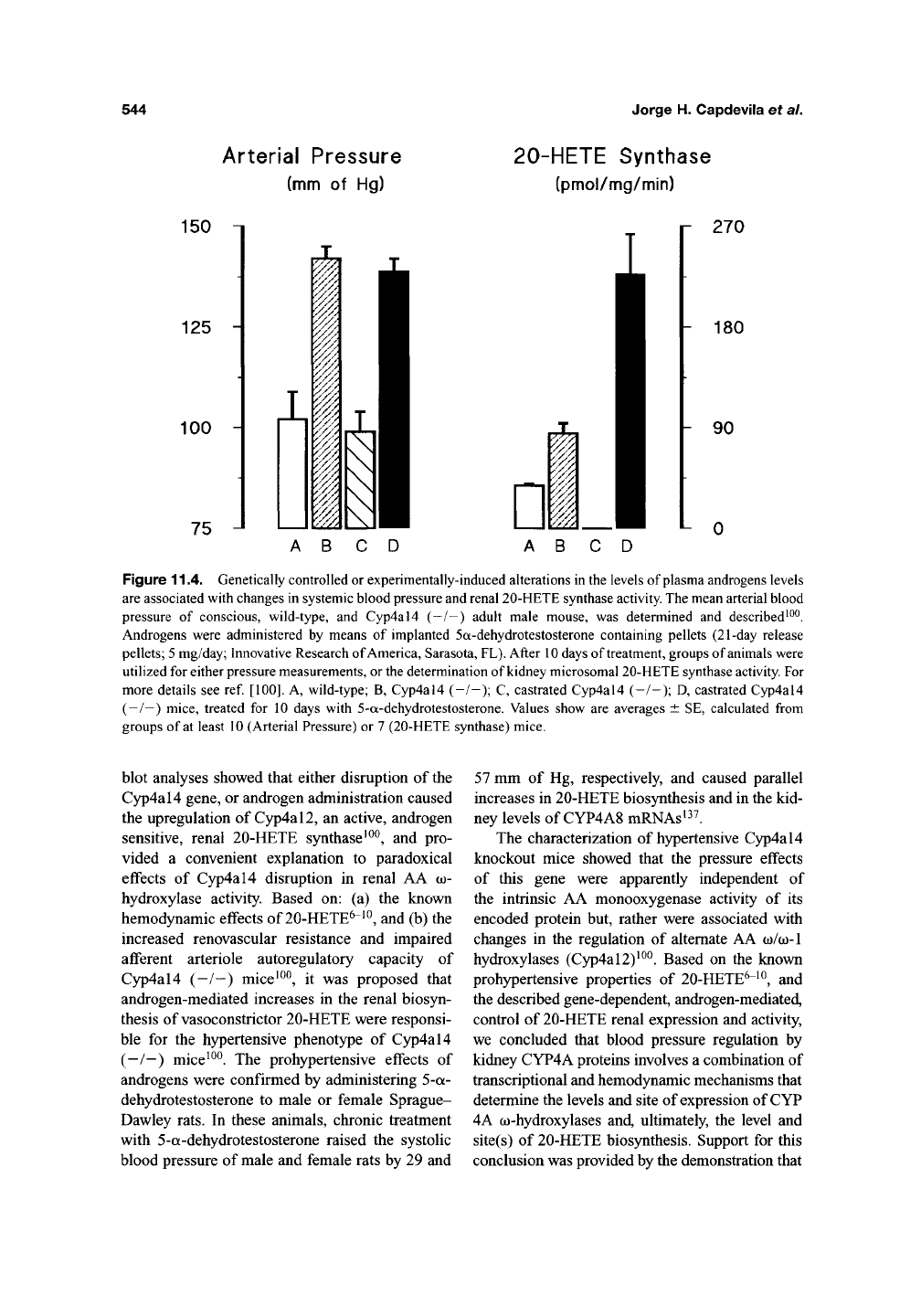
544
Jorge H. Capdevila et al.
Arterial Pressure
(mm of Hg)
150
125
100
75 -•
20-HETE Synthase
(pmol/mg/min)
D
7^
m
i
270
\- 180
90
A B C D
Figure 11.4. Genetically controlled or experimentally-induced alterations in the levels of plasma androgens levels
are associated with changes in systemic blood pressure and renal 20-HETE synthase
activity.
The mean arterial blood
pressure of conscious, wild-type, and Cyp4al4 (-/-) adult male mouse, was determined and described^^^.
Androgens were administered by means of implanted 5a-dehydrotestosterone containing pellets (21-day release
pellets;
5
mg/day; Innovative Research of America, Sarasota,
PL).
After
10
days of treatment, groups of
animals
were
utilized for either
pressure
measurements,
or the
determination of kidney microsomal 20-HETE synthase
activity.
For
more details see ref.
[100].
A, wild-type; B, Cyp4al4 (-/-); C, castrated Cyp4al4 (-/-); D, castrated Cyp4al4
(—/—) mice, treated for 10 days with 5-a-dehydrotestosterone. Values show are averages ± SE, calculated from
groups of
at
least 10 (Arterial Pressure) or
7
(20-HETE synthase) mice.
blot analyses showed that either disruption of the
Cyp4al4 gene, or androgen administration caused
the upregulation of Cyp4al2, an active, androgen
sensitive, renal 20-HETE synthase'^^, and pro-
vided a convenient explanation to paradoxical
effects of Cyp4al4 disruption in renal AA w-
hydroxylase activity. Based on: (a) the known
hemodynamic effects of 20-HETE^'^ and (b) the
increased renovascular resistance and impaired
afferent arteriole autoregulatory capacity of
Cyp4al4 (-/-) mice^^^, it was proposed that
androgen-mediated increases in the renal biosyn-
thesis of vasoconstrictor 20-HETE were responsi-
ble for the hypertensive phenotype of Cyp4al4
(—/—) mice^^^. The prohypertensive effects of
androgens were confirmed by administering 5-a-
dehydrotestosterone to male or female Sprague-
Dawley rats. In these animals, chronic treatment
with 5-a-dehydrotestosterone raised the systolic
blood pressure of male and female rats by 29 and
57 mm of Hg, respectively, and caused parallel
increases in 20-HETE biosynthesis and in the kid-
ney levels of CYP4A8 mRNAs^^?
The characterization of hypertensive Cyp4al4
knockout mice showed that the pressure effects
of this gene were apparently independent of
the intrinsic AA monooxygenase activity of its
encoded protein but, rather were associated with
changes in the regulation of alternate AA w/co-l
hydroxylases (Cyp4al2)^^^. Based on the known
prohypertensive properties of 20-HETE^^^, and
the described gene-dependent, androgen-mediated,
control of 20-HETE renal expression and activity,
we concluded that blood pressure regulation by
kidney CYP4A proteins involves a combination of
transcriptional and hemodynamic mechanisms that
determine the levels and site of expression of CYP
4A co-hydroxylases and, ultimately, the level and
site(s) of 20-HETE biosynthesis. Support for this
conclusion was provided by the demonstration that
